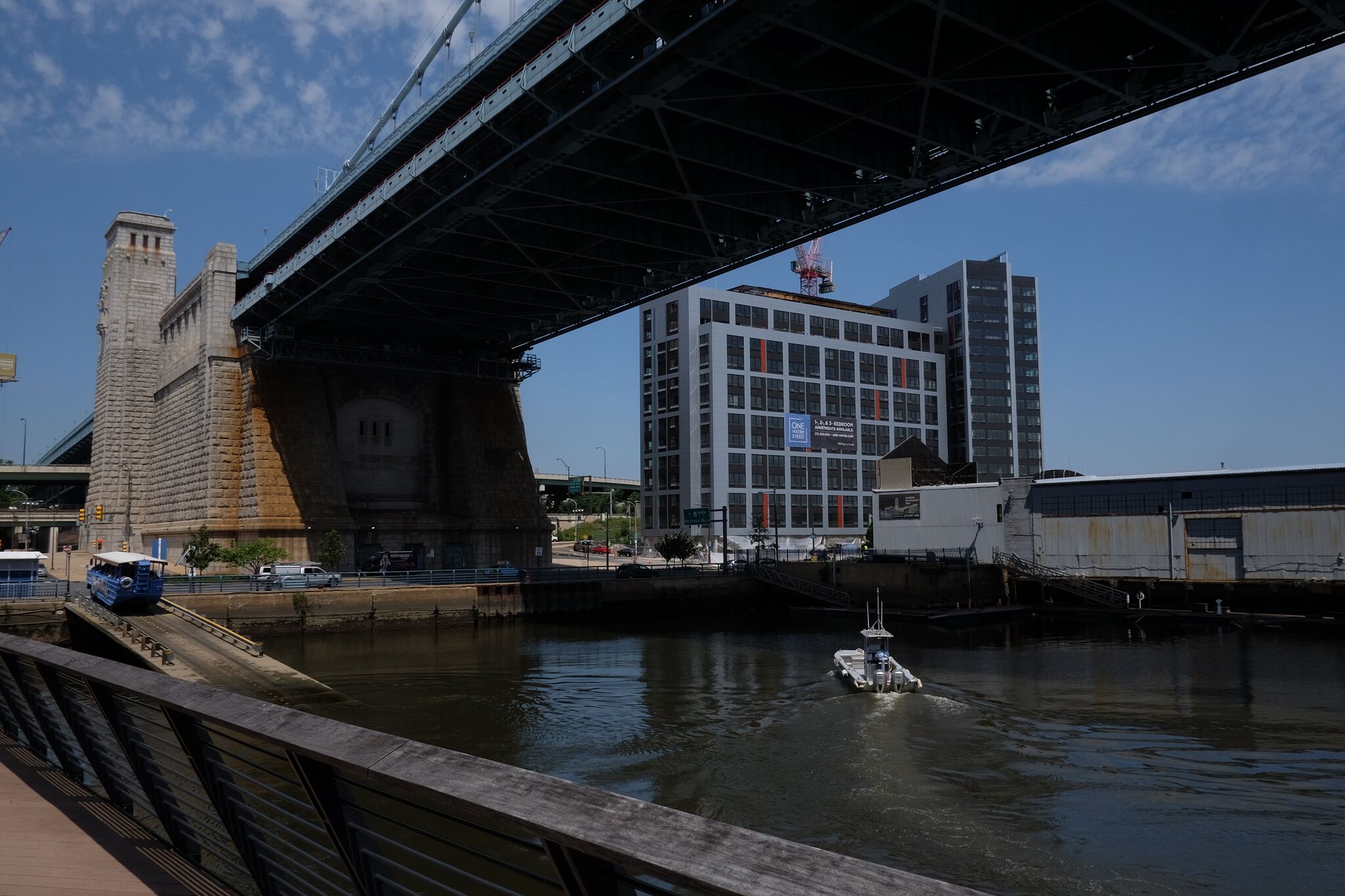Don’t misunderstand One Water Street outcome: It’s a victory

PMC agreed to include 25 affordable housing units in its nearly finished waterfront development One Water Street, taking advantage of a density bonus allowing the project extra height in exchange for those units. But as the project edged toward completion PMC wanted to work around that requirement, and proposed swapping out other amenities like public art to achieve its zoning bonus. Now after a month of jockeying, PMC has agreed to pay $3.75 million into the Housing Trust Fund to meet its obligations. Community Contributor Matt Ruben, chair of the Central Delaware Advocacy Group and PlanPhilly advisory board member, argues we should consider the outcome at One Water Street a victory. The city held its ground and advocacy helped force an outcome that upheld waterfront zoning and affordable housing policies.
Mayor Kenney, administration officials, and housing advocates have just won a tremendously important victory for affordable housing, the rule of law in zoning and development, and the future of the Central Delaware waterfront. They’ve thwarted a large waterfront development company’s effort to weasel out of its commitment to affordable housing.
This case was so important because the developer’s attempted bait-and-switch threatened to seriously undermine both the zoning overlay covering the Central Delaware and the city’s affordable-housing policy.
So this is a huge win. But you wouldn’t know it from reading some of the online reporting and the flurry of social media discussion about this case, which have contained cynical, misleading, and inaccurate claims that threaten public confidence in the city’s development rules just as much as the developer’s bad behavior did.
So here, in the form of an FAQ, are the crucial facts, and how they differ from the spurious BS.
1. What the Hell Happened?
In 2014 Property Management Corp. (PMC) got zoning approval to build 250 apartments on Columbus Boulevard, next to the Ben Franklin Bridge. Central to their project was a major density bonus, permitted under the Central Delaware waterfront zoning overlay, which gave them 48 feet of extra height in exchange for providing 25 affordable units.
Earlier this month, PMC dropped a bombshell: It no longer was willing to include the affordable units. The zoning code allowed PMC to keep that commitment in another way, by paying into the city’s Housing Trust Fund, which helps build and renovate affordable housing. But PMC didn’t want to pony up the money for that either.
Yet if PMC reneged on its commitment to affordable housing, it would lose its height bonus on the nearly-finished building. To solve this conundrum, they proposed swapping in other bonus-eligible amenities (retail space, public art, and LEED green-building certification).
2. Why Did This Make People So Angry?
This was one of the first projects zoned under the Central Delaware waterfront overlay. And it was the first project on the waterfront – and one of the first in the entire city – to take advantage of the affordable-housing density bonus system that came in with the new city zoning code in 2012.
So this was about more than 25 affordable units. The integrity of both the Central Delaware overlay and the entire citywide affordable-housing bonus system were at stake too. PMC’s attempt to swap in other bonuses was seen as shabby and selfish, putting the city’s entire zoning framework at risk because PMC seemed to be too cheap to follow through on absorbing the cost of affordable housing – a cost in exchange for which they’d gotten a massive height bonus that would earn them extra profits.
3. So Did the City Let Them Get Away with It?
Not at all. Contrary to what’s been reported and claimed online, the city held firm. Licenses and Inspections Commissioner David Perri immediately said L&I would withhold a certificate of occupancy (CO) for the building unless PMC built the affordable units or paid into the Housing Trust Fund. This was the nuclear option: PMC can’t rent out a single apartment without a CO.
PMC claimed it could “swap in” the other bonuses simply by amending its existing zoning permit, but again Perri held firm. He said if PMC wanted to back out of affordable housing and substitute other bonuses, the project would have to start all over with a brand-new zoning application.
4. But Why Did the City Let PMC Submit a New Zoning Application? Wasn’t that Spineless?
No. Our city – every city, in fact – has no legal ability to prevent a property owner from submitting a zoning application to make productive use of their land. So the city took the strictest line the law would allow.
That hard line, combined with grassroots advocacy from housing groups and direct pressure from the administration, ultimately convinced PMC to abandon their new zoning application and act like adults, making a payment of $3.75 million to the Housing Trust Fund.
5. Aha! So the City Let PMC Slide, by Letting Them Buy Their Way Out!
No. The affordable-housing bonus system gives developers the option to supply affordable units, or else make an equivalent payment to the Housing Trust Fund. So no one let PMC slide: paying into the Housing Trust Fund always was an option, and there is nothing illegal or shady about it. The only shady thing was PMC’s reluctance to pay up.
6. But Wouldn’t It Be Better if PMC Supplied the Actual Affordable Units?
Maybe. Supplying units on-site is great because it enables lower-income people and higher-income people to live together. This is good for our society, and gives lower-income people easy access to the positive amenities that often come with living in a more affluent area.
However, the law says those units have to remain affordable for only 15 years. So after a period of time, the developer could revert them to market-rate rents and kick out all the lower-income residents. By contrast, money in the Housing Trust Fund can be used to help finance units that will be affordable indefinitely, including units that can be owned, not just rented.
So there are plusses and minuses to each option – which is why the zoning code doesn’t limit the affordable housing bonus to just one or the other.
7. But PMC Paid Only $3.75 Million. That’s not enough to Build 25 New Houses!
The developer is not required to pay the actual cost of building new houses. Instead, the developer is required to pay an amount equal to the revenue they would have lost by getting the below-market rents of those 25 affordable units for 15 years. When you look at it that way, the $3.75 million PMC paid into the Housing Trust Fund is about right.
And the Housing Trust Fund also can use its resources to leverage state and federal subsidies, ultimately allowing for more affordable units to be built, not fewer.
8. But We Should Change the Law So Developers Have to Pay More!
Personally I’m all for that – but that’s a totally separate issue from whether or not the city held PMC’s feet to the fire here. And they did. So despite what you might have read, the city didn’t let PMC off easy, or negotiate a bad deal. There’s nothing shoddy about the city’s actions here, or about the outcome. PMC’s behavior was shoddy, to be sure. But the city acted properly, and the process held up.
And that’s the crucial distinction. If we let our justified cynicism about the developer turn into unjustified cynicism about the city and the process, then we erode the political will needed to protect the process in the future.
The great irony here is that PMC’s bad behavior threatened to give the Central Delaware overlay and the city’s zoning code a bad name – but if we are not careful and vigilant about the facts, then misunderstanding about this case will pose just as much of a threat as PMC did.
If you report on zoning and real estate, if you are a developer, or if you are active in following and discussing these issues online, you have a responsibility to distinguish between the actual facts and your own personal frustrations or suspicions. If you don’t, you risk doing just as much damage to our city as PMC was about to do.
WHYY is your source for fact-based, in-depth journalism and information. As a nonprofit organization, we rely on financial support from readers like you. Please give today.




